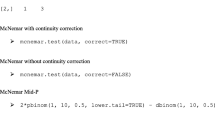Abstract
We address the problem of design optimization for individual and population pharmacokinetic studies. We develop Splus generic functions for pharmacokinetic design optimization: IFIM, a function for individual design optimization similar to the ADAPT II software, and PFIM_OPT, a function for population design optimization which is an extension of the Splus function PFIM for population design evaluation. Both evaluate and optimise designs using the Simplex algorithm. IFIM optimizes the sampling times in continuous intervals of times; PFIM_OPT optimizes either, for a given group structure of the population design, only the sampling times taken in some given continuous intervals or, both the sampling times and the group structure, performing then statistical optimization. A combined variance error model can be supplied with the possibility to include parameters of the error model as parameters to be estimated. The performance of the optimization with the Simplex algorithm is demonstrated with two pharmacokinetic examples: by comparison of the optimized designs to those of the ADAPT II software for IFIM, and to those obtained using a grid search or the Fedorov–Wynn algorithm for PFIM_OPT. The influence of the variance error model on design optimization was investigated. For a given total number of samples, different group structures of a population design are compared, showing their influence on the population design efficiency. The functions IFIM and PFIM_OPT offer new efficient solutions for the increasingly important task of optimization of individual or population pharmacokinetic designs.
Similar content being viewed by others
REFERENCES
L. Aarons. Software for population pharmacokinetics and pharmacodynamics. Clin. Pharmacokinet. 36:255-264 (1999).
L. Sheiner and J. Wakefield. Population modelling in drug development. Statistical Methods in Medical Research 8:183-193 (1999).
N. H. G. Holford, H. C. Kimko, J. P. R. Monteleone, and C. C. Peck. Simulation of clinical trials. Annu. Rev. Pharmacol. Toxicol. 40:209-234 (2000).
Trial Simulator Version 2.1.2, Pharsight Corporation, 2000.
M. K. Al-Banna, A. W. Kelman, and B. Whiting. Experimental design and efficient parameter estimation in population pharmacokinetics. J. Pharmacokinet. Biopharm. 18:347-360 (1990).
E. N. Jonsson, J. R. Wade, and M. O. Karlsson. Comparison of some practical sampling strategies for population pharmacokinetic studies. J. Pharmacokinet. Biopharm. 24:245-263 (1996).
J. Wang and L. Endrenyi. A computationally efficient approach for the design of population pharmacokinetic studies. J. Pharmacokinet. Biopharm. 20:279-294 (1992).
A. C. Atkinson and A. N. Donev. Optimum Experimental Designs. Clarendon Press: Oxford (1992).
E. Walter and L. Pronzato. Identification of Parametric Models. Springer: New York (1997).
D. Z. D'Argenio and A. Schumitzky. ADAPT II User's Guide: Pharmacokinetic/ Pharmacodynamic Systems Analysis Software. Biomedical Simulations Resource: Los Angeles (1997).
S. Retout, S. Duffull, and F. Mentre. Development and implementation of the population Fisher information matrix for the evaluation of population pharmacokinetic designs. Comput. Methods. Programs. Biomed. 65:141-151 (2001).
F. Mentré, A. Mallet, and D. Baccar. Optimal design in random-effects regression models. Biometrika 84:429-442 (1997).
S. Retout and F. Mentré. Further developments of the Fisher information matrix in nonlinear mixed effects models with evaluation in population pharmacokinetics. J. Biopharm. Stat. 13:209-227 (2003).
F. Mentré, C. Dubruc, and J. P. Thenot. Population pharmacokinetic analysis and optimization of the experimental design for mizolastine solution in children. J. Pharmacokinet. Pharmacodyn. 28:299-319 (2001).
S. Retout, F. Mentré, and R. Bruno. Fisher information matrix for nonlinear mixed-effects models: evaluation and application for optimal design of enoxaparin population pharmacokinetics. Stat. Med. 21:2623-2639 (2002).
M. Tod, F. Mentré, Y. Merlé, and A. Mallet. Robust optimal design for the estimation of hyperparameters in population pharmacokinetics. J. Pharmacokinet. Biopharm. 26:689-716 (1998).
S. B. Duffull, F. Mentré, and L. Aarons. Optimal design of a population pharmacodynamic experiment for ivabradine. Pharm. Res. 18:83-89 (2001).
S. B. Duffull, S. Retout, and F. Mentré. The use of simulated annealing for finding optimal population designs. Comput. Methods. Programs. Biomed. 69:25-35 (2002).
A. C. Hooker, M. Foracchia, M. G. Dodds, and P. Vicini. An evaluation of population D-optimal designs via pharmacokinetic simulations. Ann. Biomed. Eng. 31:98-111 (2003).
D. Z. D'Argenio. Incorporating prior parameter uncertainty in the design of sampling schedules for pharmacokinetic parameter estimation experiments. Math. Biosci. 99:105-118 (1990).
Y. Merle and M. Tod. Impact of pharmacokinetic-pharmacodynamic model linearization on the accuracy of population information matrix and optimal design. J. Pharmacokinet. Pharmacodyn. 28:363-388 (2001).
M. Tod and J. M. Rocchisani. Comparison of ED, EID, and API criteria for the robust optimization of sampling times in pharmacokinetics. J. Pharmacokinet. Biopharm. 25:515-537 (1997).
J. A. Nelder and R. Mead. A simplex method for function minimization. Comput J. 7:308-313 (1965).
W. H. Press, S. A. Teukolsky, W. T. Vetterling, and B. P. Flannery. Numerical Recipies in C. 2nd edition. Cambridge University Press: New York (1992).
http://cceb.med.upenn.edu/heitjan/optimize/optfcn.q
S. L. Beal and L. B. Sheiner. NONMEM users guides. University of California San Francisco, San Francisco: CA (1992).
Author information
Authors and Affiliations
Rights and permissions
About this article
Cite this article
Retout, S., Mentré, F. Optimization of Individual and Population Designs Using Splus. J Pharmacokinet Pharmacodyn 30, 417–443 (2003). https://doi.org/10.1023/B:JOPA.0000013000.59346.9a
Issue Date:
DOI: https://doi.org/10.1023/B:JOPA.0000013000.59346.9a




